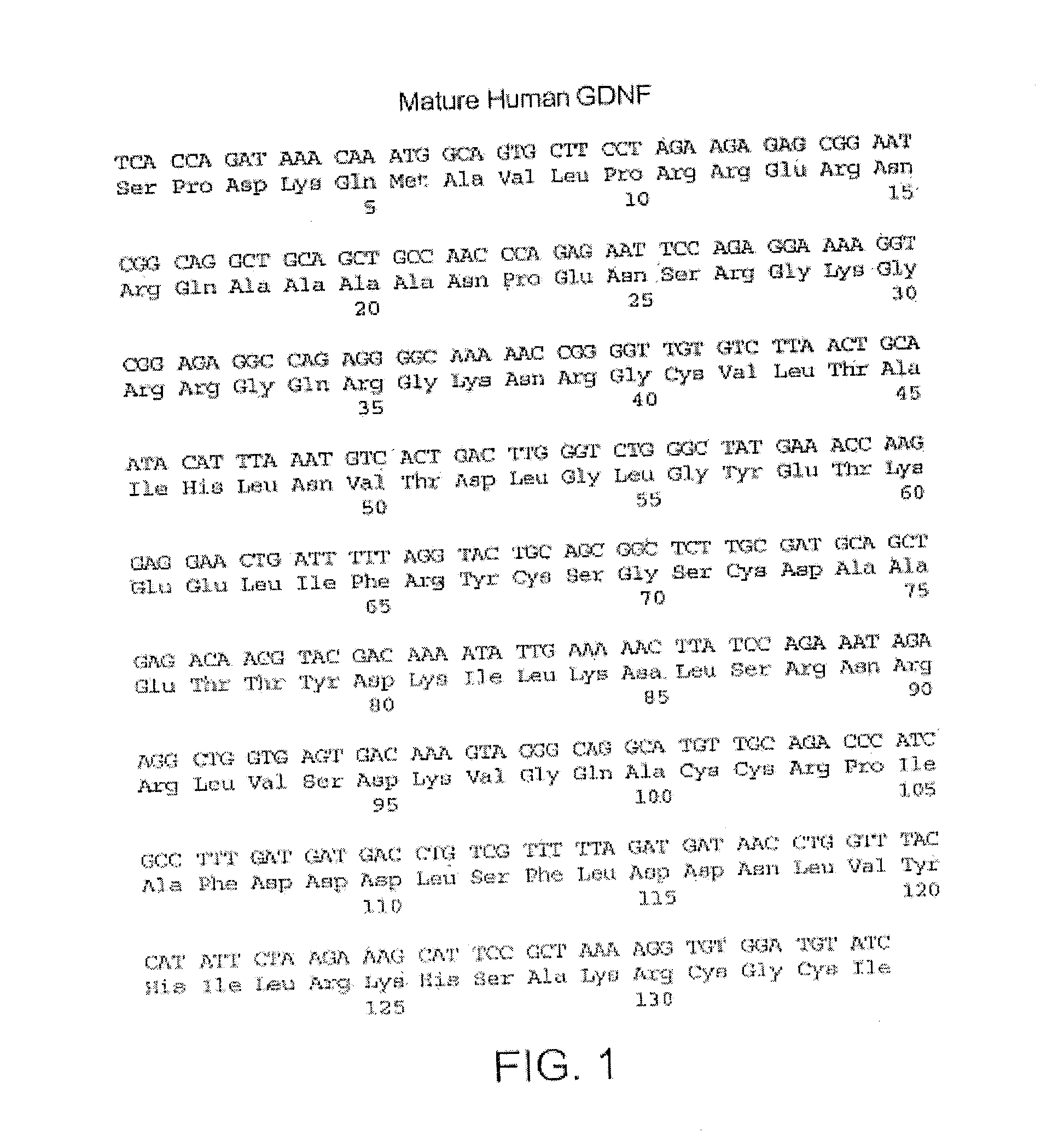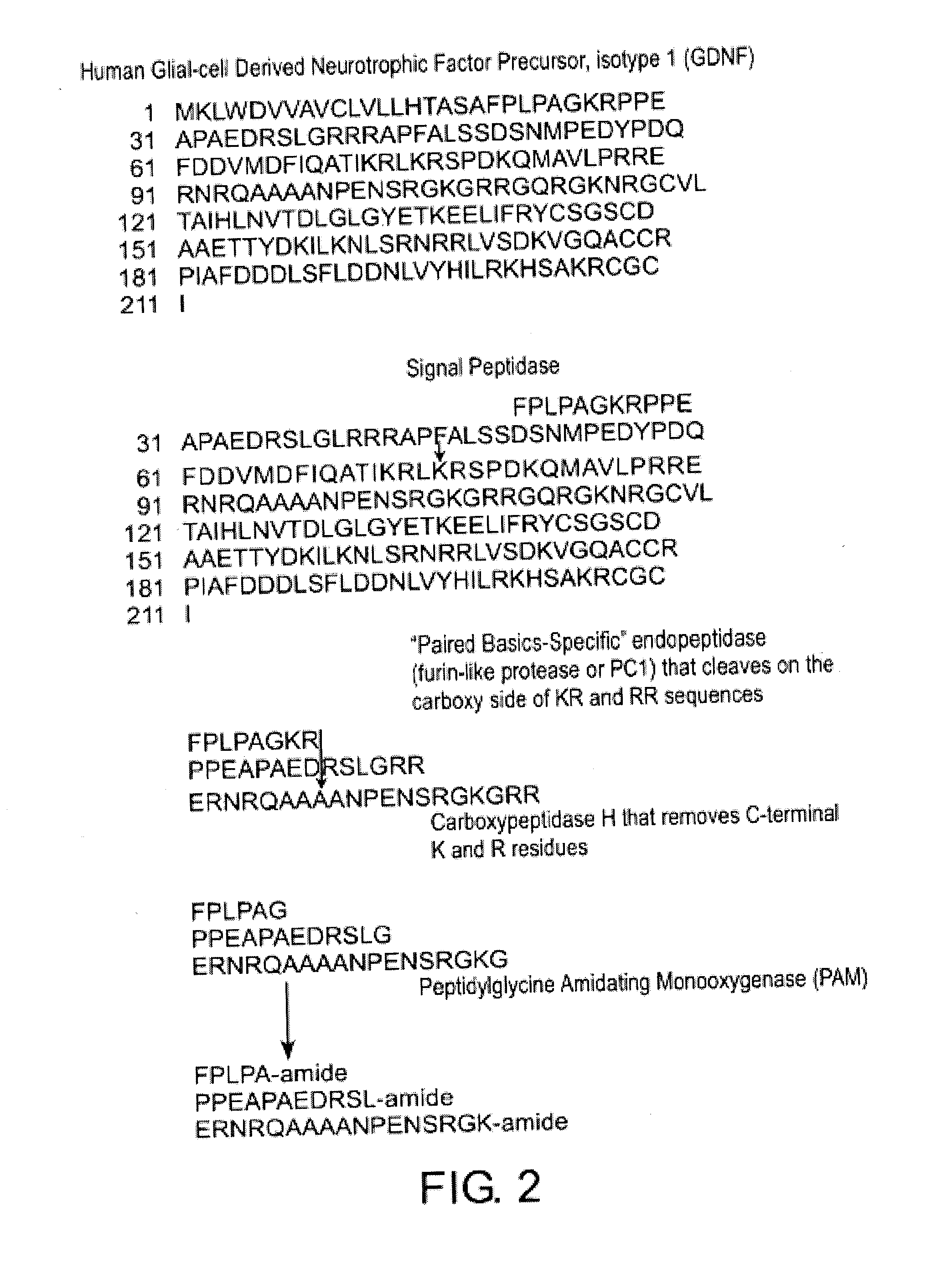Amidated Dopamine Neuron Stimulating Peptides for CNS Dopaminergic Upregulation
a dopaminergic and cns dopaminergic technology, applied in the field of new drugs, can solve the problems of no statistically significant differentiation between the placebo and active treatment group, ineffective infusion of cerebrospinal fluid in humans, and large number of neurons in many brain regions
- Summary
- Abstract
- Description
- Claims
- Application Information
AI Technical Summary
Benefits of technology
Problems solved by technology
Method used
Image
Examples
example 1
BLAST Analysis
[0069]The three hypothetical precursor segments (RRERNRQAAAANPENSRGKGRR (SEQ ID NO: 5); FPLPAGKR (SEQ ID NO: 8); and KRPPEAPAEDRSLGRR (SEQ ID NO: 7); see FIG. 3) were subjected to BLAST searches for short, nearly identical sequences. RRERNRQAAAANPENSRGKGRR (SEQ ID NO: 15) is present in GDNF splice forms 1 and 2. There are some sequence variations by species, but consensus post-translational processing signals are maintained across species. FPLPAGKR (SEQ ID NO: 8) was found to be invariant in the available GDNF splice form 1 sequences, but does not occur in splice forms 2 and 3. KRPPEAPAEDRSLGRR (SEQ ID NO: 7) scored hits in splice form 1, but not in the other GDNF splice forms. There are some sequence variations by species, but consensus processing signals are maintained across species. Thus, these ADNS peptides are unique to mostly splice form 1 of GDNF and not other splice forms of the pre pro GDNF.
example 2
Synthesis of ADNS Peptides
[0070]Three peptides, designated GER9263, GER9264, and GDR9265 (see Table 1, below) were synthesized by Keck Biotechnology Resource Laboratory, Yale University New Haven, Conn. Synthetic peptides can be made routinely up to 40 residues and often, depending on sequence, up to 70 residues by this facility. All peptides were separated and purified on a preparative C-18 or C-4 RP-HPLC system and delivered as a lyophilized material. Yields for normal peptides under 40 residues were “guaranteed” at 50 mg or more and at 90+% purity. Yields and purity are often higher, varying with the peptide sequence and length. All peptides made in the Keck facility at the 0.5 mmole scale are done by tBOC chemistry and at a single scale range (which generates a theoretical crude yield of 500-1,000 mg for a 10-20 mer respectively). The purified peptides were characterized by analytical RP-HPLC, amino acid analysis, and FAB mass spectroscopy.
TABLE 1 ADNS peptidesPeptideSequenceGER...
example 3
Dopaminergic Activity of ADNS Peptides in Fischer 344 Rats
[0071]Experiments were performed to test the effects of the three ADNS peptides (GER9263, GER9264, and GDR9265) on dopaminergic activity in normal young adult male Fischer 344 rats. The peptides were combined in a 1:1:1 ratio. There were three test groups with six animals per group: vehicle (citrate buffer), vehicle plus 30 μg peptide mixture, and vehicle plus 100 μg peptide mixture. The vehicle or vehicle plus peptide solutions were steriotaxically injected in equal portions into two sites each in the right substantia nigra.
[0072]One month after drug administration, the basal levels of dopamine and dopamine metabolites were measured by microdialysis in the right striatum. Potassium and amphetamine evoked release of dopamine were also evaluated.
[0073]While basal levels of dopamine were not significantly altered in the striatum, average K+-evoked release of dopamine increased by over 50% (FIG. 4). Average amphetamine-evoked re...
PUM
| Property | Measurement | Unit |
|---|---|---|
| concentration | aaaaa | aaaaa |
| concentration | aaaaa | aaaaa |
| time | aaaaa | aaaaa |
Abstract
Description
Claims
Application Information
 Login to View More
Login to View More - R&D
- Intellectual Property
- Life Sciences
- Materials
- Tech Scout
- Unparalleled Data Quality
- Higher Quality Content
- 60% Fewer Hallucinations
Browse by: Latest US Patents, China's latest patents, Technical Efficacy Thesaurus, Application Domain, Technology Topic, Popular Technical Reports.
© 2025 PatSnap. All rights reserved.Legal|Privacy policy|Modern Slavery Act Transparency Statement|Sitemap|About US| Contact US: help@patsnap.com



